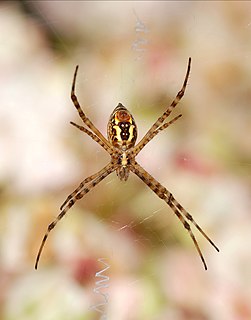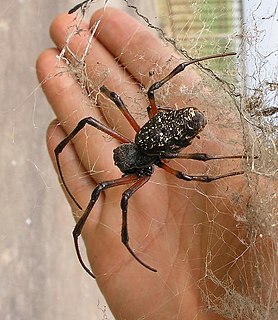 W
WArgiope argentata, commonly known as the silver argiope due to the silvery color of its cephalothorax, is a member of the orb-weaver spider family Araneidae. This family is also known as the orb-weaving family. This species of spider resides in South America, Central America, Southern California, Florida, Arizona, Texas, and the Caribbean. They are known to reside amongst arid and warm environments. A. argentata create stabilimenta and a unique zig-zag in its web design, and it utilizes its UV-reflecting silk to attract pollinating species to prey upon. Like other species of Argiope, its venom is not harmful to humans; however, it can be employed to immobilize its prey. A. argentata engages in sexual cannibalism either mid- or post-copulation. One aspect of particular interest regarding this species is its extinction patterns, which notably have minimal correlation with its population size but rather occur sporadically for the species.
 W
WArgiope trifasciata is a species of spider native to North and South America, but now found around the world. It can be found in certain areas of Europe, namely the Iberian Peninsula, the Canary Islands, and Madeira, The similar looking Argiope bruennichi is common in the Azores. They typically begin to appear during autumn from early September to late October as temperatures start dropping.
 W
WAttulus pubescens is a species of jumping spiders. Until 2017, it was known as Sitticus pubescens.
 W
WDictyna latens is a species of spider found in Europe to Central Asia.
 W
WCyrtophora citricola, also known as the tropical tent-web spider, is an orb-weaver spider that can be found in Asia, Africa, Australia, Costa Rica, Hispaniola, Colombia, and the warmer parts of Europe. In 2000, it was also discovered in Florida.
 W
WEbrechtella tricuspidata is a species of crab spiders belonging to the family Thomisidae.
 W
WGasteracantha fornicata is a species of spiny orb-weavers found in Queensland Australia. It is similar in shape to Austracantha minax which was originally described as Gasteracantha minax. It was described by Johan Christian Fabricius in 1775, the first Australian species of spider to be named and classified.
 W
WLatrodectus mactans, known as southern black widow or simply black widow, and the shoe-button spider, is a venomous species of spider in the genus Latrodectus. The females are well known for their distinctive black and red coloring and for the fact that they will occasionally eat their mate after reproduction. The species is native to North America. The venom is seldom fatal to healthy humans.
 W
WNephilingis cruentata is an araneid spider with a strikingly red sternum.
 W
WPholcus phalangioides, commonly known as daddy long-legs spider or long-bodied cellar spider, is a spider of the family Pholcidae. It is also known as the skull spider due its cephalothorax resembling a human skull. This is the only spider species described by the Swiss entomologist Johann Kaspar Füssli, who first recorded it for science in 1775. Females have a body length of about 8 mm while males tend to be slightly smaller. The length of the spider's legs are on average 5 or 6 times the length of its body. Pholcus phalangioides has a habit of living on the ceilings of rooms, caves, garages or cellars. This spider species is considered beneficial in parts of the world because it kills and eats other spiders, including species considered dangerous such as redback spiders. Pholcus phalangioides is known to be harmless to humans and provides many benefits to humans, including the potential for the medicinal use of their webs.
 W
WSynema globosum is a species of spiders belonging to the family Thomisidae. It is sometimes called the Napoleon spider, because of a supposed resemblance of the markings on the abdomen to a silhouette of Napoleon wearing his iconic hat.